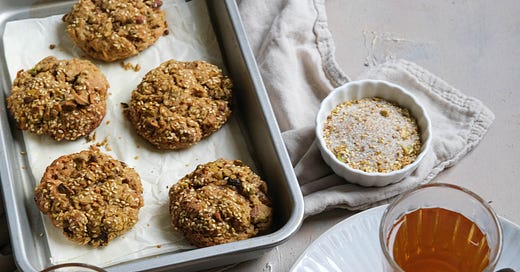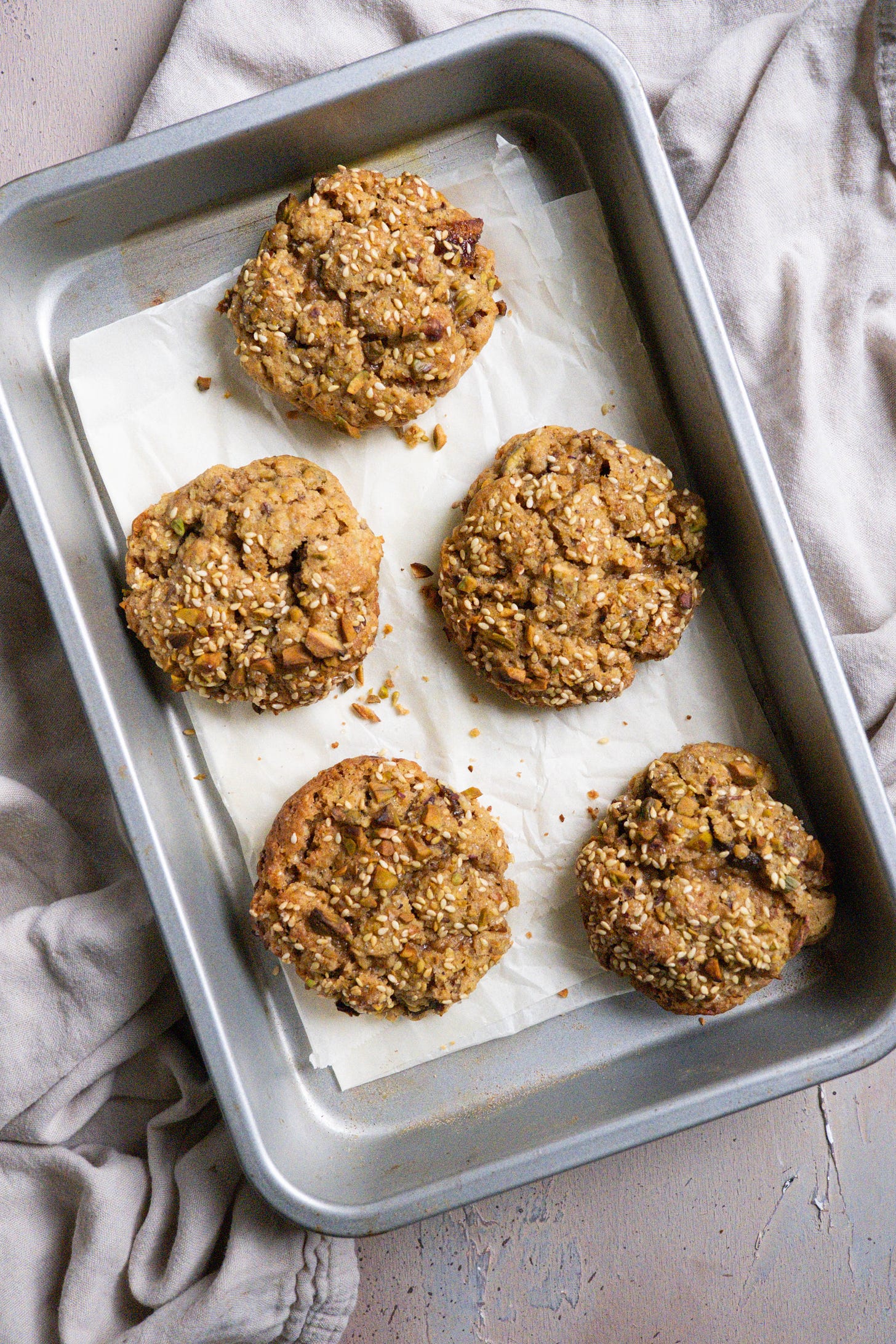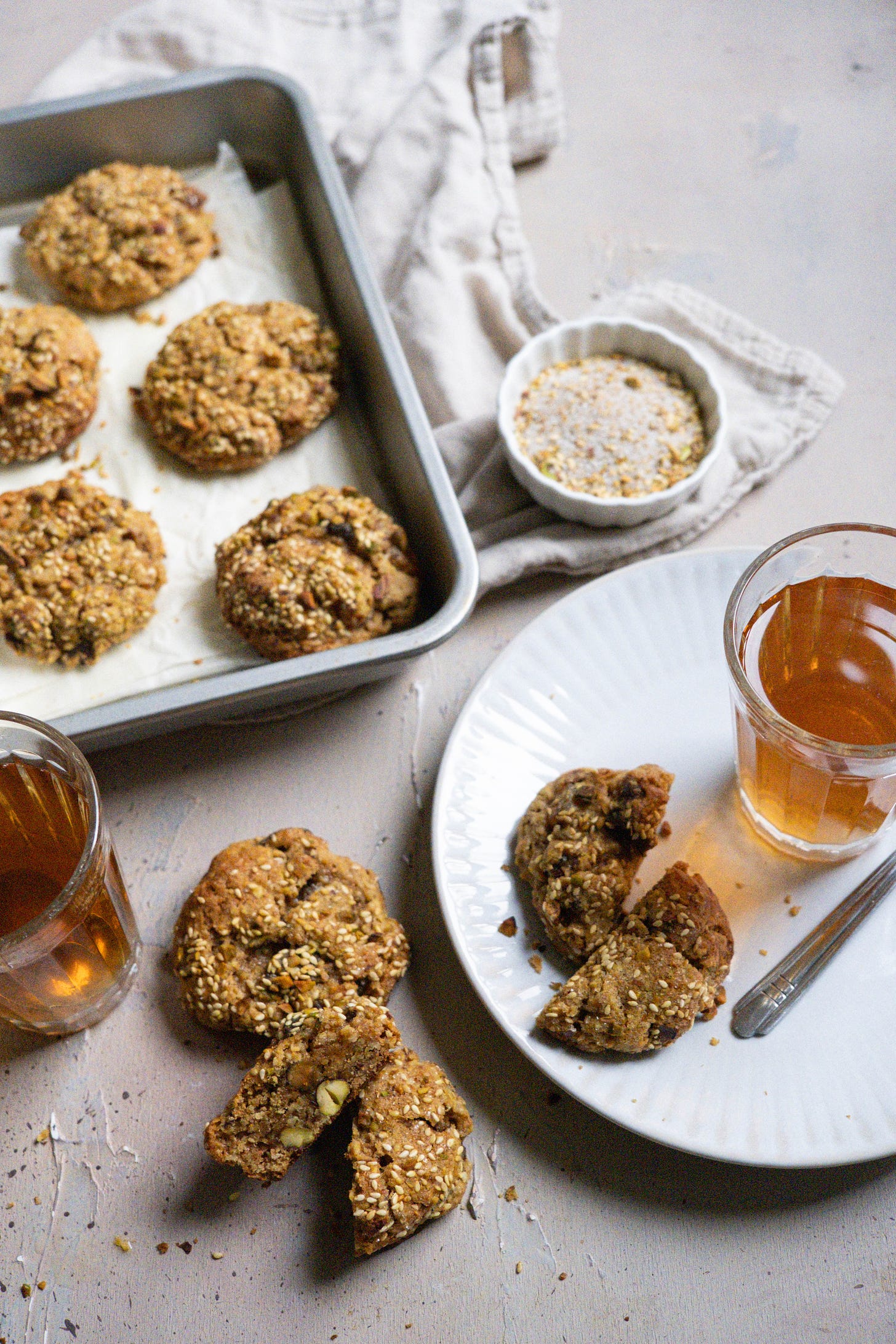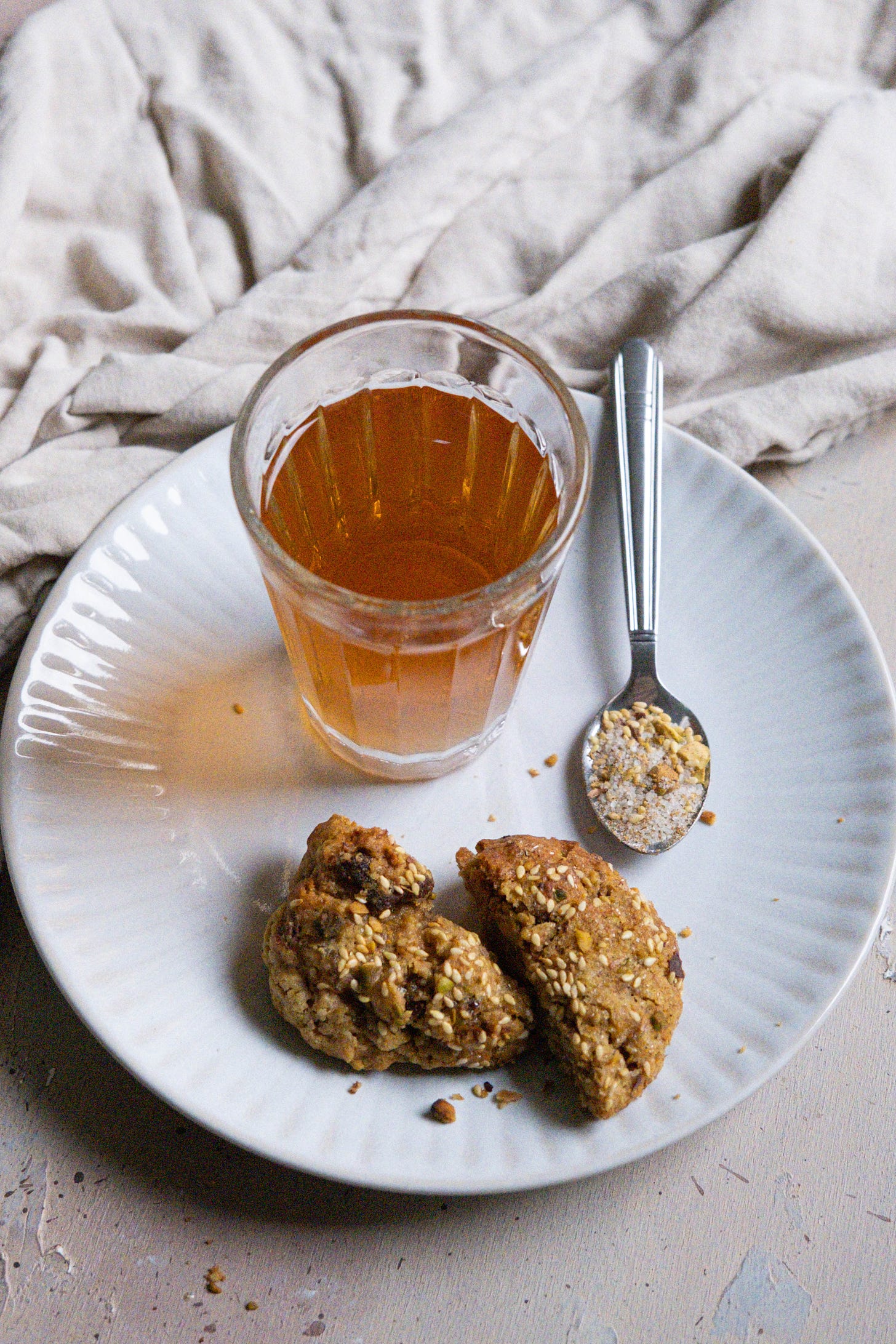Hello, and welcome to Newsletter No 26 here on Substack! Thank you for stopping by. If you are already subscribed, thank you for supporting my work, it means the world to me! If not, grab a seat if you are interested in recipes as well as tips and tricks to make the most of our increasingly eclectic pantries and a good dose of my at times random musings about all things food - and make sure you hit that subscribe button if you don’t want to miss any future posts!
For this week’s recipe post I thought I would make an exception and instead of sharing a new recipe of my own, share a recipe from my friend Kaja’s book Cookies and Crumbs which has just been published in English (and which you can buy here (BE), here (UK) and here (US), for example).
If you found your way to my Substack via Instagram or my old Blog, you will remember that pre-Pandemic Kaja and I used to host a supperclub in Brussels (turning my old one bedroom apartment in Chatelain into a make-shift restaurant every few weeks is one of the fondest memories I have of that little place I called home for 5 years!). In 2019, Kaja left her lobbying days in the EU-bubble in Brussels behind and moved to Stockholm with her boyfriend. There she decided to throw herself head first into her biggest passion: food. Getting up at the crack of dawn (well, technically before the crack of dawn) to stage in one of Stockholm’s bakeries to learn all the tricks of the trade, hosting online sourdough classes over Zoom during the Pandemic and, quickly thereafter, starting her cookie business Krümel (German meaning ‘a crumb’) from her home kitchen.
When Krümel started taking off, she opened her first brick and mortar shop in Stockholm where customers could also sit down for a hot drink (or a cold glass of milk) while enjoying her cookies. Soon thereafter she started working on her first book, Cookies & Crumbs, which was initially published in Swedish only (did I mention that Kaja also didn’t speak any Swedish when she first arrived in Stockholm - imagine navigating entrepreneurship and the cookbook writing business for the first time in a foreign language?!). Shortly after opening her second brick and mortar shop in Stockholm earlier this year, her book has finally been published in English as well so those of us living outside of Sweden can finally also enjoy her cookies.
If you are wondering whether you really need a dedicated cookbook about cookies on your shelf, then the answer is a resounding “yes” if you like playing with different flavours but don’t want to go through all the experimentation of figuring out the necessary ratios and quantities yourself. Because Kaja has taken care of that for you.
One flick through the book and you will be immediately impressed by the incredible range of flavours and flavour combinations that Kaja draws upon to make her cookies - influenced by the many places she has called home and the many more places she has visited on all her travels. In the 30 or so recipes in the book there is a nod to her Brussels days with a Biscoff spread filled cookie and a wink to her new home, Stockholm, with a Double Chocolate and Licorice Cookie. Beyond that (and the classic chocolate chip cookies which cannot be omitted from a book all about cookies!) there are recipes for cookies with Prune and Chinese Five Spice Powder, Sumac, Coffee, Lapsang Souchong (a neat little trick to add a smokey note to your cakes, baked goods and desserts!), Saffron and many, many more.
That being said, the book also contains plenty of information on how to achieve your desired cookie texture and what impact different mixing methods (and times) as well as whether you add your butter cold, at room temperature or melted to the dough have on the final cookie. There are recipes for “gooey and chunky” cookies, “gooey and soft” as well as “chewy and soft” cookies. And for those following special diets, there are also a number of vegan and gluten free recipes. And to round it all off, Kaja also shares some ideas for what to make with any leftover cookies.
Kaja was kind enough to let me share a recipe from her book in my newsletter this week. Unsurprisingly it was hard to decide which cookies to bake first - there are so many delicious and intriguing recipes in her book! In the end I settled on the Oat Cookies with Apricot & Pistachio Dukkah from the Gooey and Chunky chapter of her book.
As Kaja says in her book oat cookies are a sort of “proto-cookie”. But this is not your regular oat cookie because what makes them stand out and oh so delicious is that Pistachio Dukkah - which includes a generous dose of Ras El Hanout, Cardamom and Cinnamon. While there is no definitive list of ingredients for the Moroccan spice mix Ras El Hanout it typically includes cardamom, cumin, clove, cinnamon, nutmeg, mace, all spice; ginger, pepper, coriander, pepper, paprika, fenugreek and turmeric. It is earthy and has a little bit of a kick – something I have found pairs well with butternut squash, sweet potatoes, carrots etc. when it comes to baking cakes. As I discovered thanks to Kaja, Ras El Hanout also works a treat in cookies. In fact, the Dukkah these cookies are rolled in prior to baking tastes so good I can’t wait to scatter the leftovers over my morning bowls of porridge in the coming days!
What are your favourite cookie? And do you have a favourite cookie recipe? Also, have you ever baked with Ras El Hanout?
Oat Cookies with Apricot & Pistachio Dukkah
Note: The secret to these cookies being tall and chunky and extra gooey in the centre is to take them out of the oven at exactly the right moment in time, so after ca. 9-10 minutes. You basically want to take them out just before they start to crack and flatten. So watch your oven like a hawk in the last few minutes and, if in doubt, take them out already.
Reprinted with permission from Cookies & Crumbs
Makes 20 cookies
Ingredients
230g butter at refrigerator temperature, diced
210g light muscovado sugar
70 caster (granulated ) sugar
3g (1 tsp) vanilla powder or 2 tsp vanilla extract
2 eggs
350g plain (all-purpose) flour
30g cornflour (cornstarch)
140g rolled oats
3g (1 ½ tsp) ras el hanout
3g (1 tsp) bicarbonate of soda (baking soda)
5g (1 ⅔ tsp) baking powder
|1 1/2g (½ tsp) salt
140g dried apricots, roughly chopped
130g roasted pistachios
Dukkah
3 tbsp toasted white sesame seeds
50g roasted pistachios, finely chopped
1 tsp ras el hanout
½ tsp ground cardamom
¼ tsp ground cinnamon
75g caster (granulated) sugar
½ tsp sea salt flakes
Directions
Combine all the dukkah ingredients in a bowl.
Add the butter to your food processor or to the bowl of a stand mixer fitted with a paddle attachment and mix on a medium speed for 15 seconds until the butter begins to break up. Add the sugars and the vanilla, then mix until the sugar has roughly combined with the butter. Scrape the butter from the sides of the bowl.
Add the eggs and mix for a maximum of 20 seconds until they are just combined. Make sure you don’t mix for too long.
Combine the flours, oats, ras el hanout, bicarbonate of soda, baking powder and salt in a separate bowl. Add the dry ingredients to the butter mixture in two batches, mixing for 10–15 seconds between each batch until everything is just combined. Scrape down the base and sides of the bowl between each round of mixing.
Add the apricots and pistachios. Mix at a low speed until they are all roughly combined.
Scoop 75g (2½oz) rough balls of dough using an ice cream scoop, or roll balls using 3 tablespoons of dough. This should be enough for about 20 cookies. Dip one side of each cookie in the dukkah. Place the dough balls in a container with a lid or on a tray that you then cover with cling film (plastic wrap). Leave to rest in the refrigerator for at least 3 hours – preferably overnight.
Preheat the oven to 190°C fan (210°C/410°F/gas 6–7).
Place the dough balls, dukkah-side up, approximately 5cm (2in) apart on baking trays lined with baking parchment. Bake in the middle of the oven for 9–10 minutes. Bake one sheet at a time if not using a fan oven. The cookies should have expanded a bit, risen and begun to firm, but should not have cracked.
Transfer them to a cooling rack and leave to cool for at least another 10–15 minutes.







